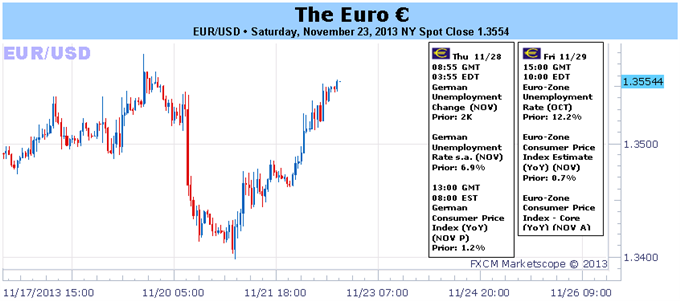
Fundamental Forecast for Euro: Bullish
– The Euro’s pullback midweek may have been the time to go long.
– Price and time cycles point to the EURUSD hitting a near-term top shortly…
– …but the Euro has benefited from the recent turmoil in the commodity currencies.
The Euro’s resilience in the wake of the European Central Bank’s surprise 25-bps rate cut continued this past week, finishing only -0.44% behind the top performer of the week, the Swiss Franc, while boasting a +2.43% return against the worst performer, the Australian Dollar. If one thing was clear, it was that investors were in high demand for European currencies over the past five days. Consider that of the ten major currencies, five gained versus the US Dollar, and all were from Europe (vs USD): CHF +0.90%; SEK +0.83%; NOK +0.82%; GBP +0.67%; and EUR +0.46%.
It’s becoming more and more evident that, absent a further deterioration in data, negativity regarding the European continent has been priced in. It should be considered a positive sign for the Euro that non-Euro using countries are seeing their currencies appreciate as alongside; it speaks well to market participant’s outlook on the entire region’s growth.
The gains across Europe this week are even more unambiguous when illuminated by the fact that the Federal Reserve’s October meeting Minutes very much left open the possibility of a QE3 taper in December contingent on “improving data.” With the meeting having occurred before the October NFP figures were available, it is very likely that we’ve seen a major data point move in favor of a December taper given how handily the headline beat expectations. If QE3 taper expectations start to gather – and there was evidence this week as the US yield curve steepened – it will be difficult for the Euro to keep grinding out only modest gains against the US Dollar.
The Euro may still benefit elsewhere, however, as was seen this week. The commodity currencies hemorrhaged ground across the board from late-Wednesday through Friday’s close (thanks to the Fed), and there was clear evidence of a rotation out of the higher yielding currencies into lower yielding but growth-friendly currencies – the European bloc.
Recent data and policy signals out of Europe this past week were far from soothing for Euro bulls. On one end, French and broader Euro-Zone PMI figures were rather tepid, and speculation arose (briefly) that the ECB would consider cutting its main rate into negativity territory. On the other, German PMIs improved, the German IFO survey improved, and ECB President Mario Draghi rebutted the notion of negative deposit rates. There are both positives and negatives, but for now, the positives seem to be edging out and it is looking like that the ECB will keep policy unchanged at its December meeting.
This coming week, there are only a few important events on the calendar, and with a holiday in the US that will cut liquidity out by Wednesday, diminished market participation rates might buffer reactions to any incoming data. Of note, German labor market data for November is due on Thursday, which could see a further steadying in light of the IFO survey.
But the big data prints are the inflation readings for Germany and the Euro-Zone. The ECB cut its key rate earlier this month after October’s figures showed deflation in Germany and a post-crisis low in inflation in the Euro-Zone. Should these figures show even modest improvement after the dip at the start of the 4Q’13, the Euro may see its strength extend from the commodity bloc to some more of its resilient rivals over the past few weeks, the British Pound and the US Dollar, as the calendar turns to the last month of the year. –CV
To receive reports from this analyst, sign up for Christopher’s distribution list.
DailyFX provides forex news and technical analysis on the trends that influence the global currency markets.Learn forex trading with a free practice account and trading charts from FXCM.
Source: Daily fx

